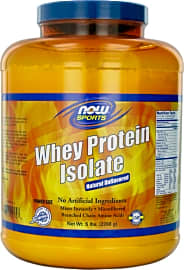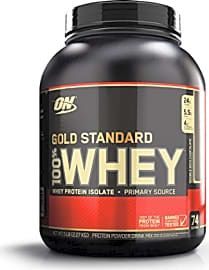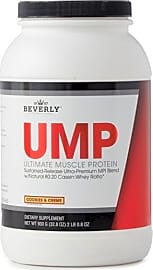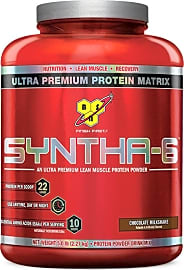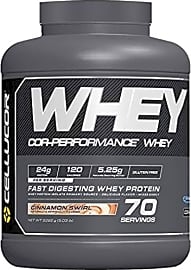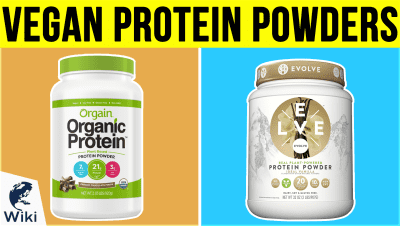The 10 Best Protein Powders

This wiki has been updated 44 times since it was first published in February of 2015. If you've been hitting the gym like crazy, but still aren't seeing the results you'd like, you may not be giving your muscles the fuel they need to be at their best. These whey protein powders may provide the nutrition necessary to reach new heights, so you can enjoy the fruits of your labors. They can used to make satisfying smoothies, and some can even be mixed or baked into foods. When users buy our independently chosen editorial selections, we may earn commissions to help fund the Wiki.
Editor's Notes
February 18, 2021:
At this time we have determined that no changes need to be made to our current recommendations. There are many protein powders on the market, so many so that most people will find choosing one from the sheer number of offerings a difficult task, however our selection represents the best of the bunch in variety of flavors and formulas.
You'll notice that all of the powders here are whey based, which comes in a concentrate, isolate, or hydrolyzed form. Each of these has its own benefits. Concentrate, like the kind found in Pure Label Nutrition and TGS All Natural is often best for those looking to use a protein powder as a meal replacement because it is still contains a higher amount of lactose, sugar, and fat than the other two types, and it takes longer to be digested by the body and absorbed by the muscles. This means it can help keep you fuller for longer. Isolate has most or all of the lactose, sugar, and/or fat removed, resulting in a powder that is usually around 90 percent protein. You'll find this in Legion Low Calorie and Now Sports Whey Protein Isolate. The final type, hydrolyzed is essentially predigested, which makes it very easy for the body to break down, so it gets absorbed very rapidly. This kind is found in Sascha Fitness.
It is worth mentioning that many powders combine two forms of protein, often concentrate and isolate, as can be seen in Optimum Nutrition Gold Standard, CytoSport Muscle Milk, Beverly International UMP, BSN Syntha-6, and Cellucor Cor-Performance.
Vegans will want to avoid any of the options here, as whey comes from milk. However, they can still get the protein they need to build muscle by choosing something from our list of vegan protein powders.
April 25, 2019:
This list includes some of the most highly-lauded protein powders out there, and although taste is a highly subjective, personal matter, we opted for selections with a wide variety of palatable flavors and some with no taste at all, like TGS All Natural, to cater to everyone's needs. Pure Label Nutrition, TGS All Natural, and Legion Low Calorie commanded the top three spots thanks to their lack of fillers and additives and thoughtfully-sourced ingredients, which when combined, gives users the boost they need without bloating, gas, or stomachaches.
For baking, Beverly International UMP is a top choice, while those who can't stand aggressive aftertastes or super thick consistencies will appreciate Optimum Nutrition Gold Standard, which mixes extremely well with almost anything. BSN Syntha-6 is good for serious athletes who know how to balance their supplements with diet to increase bulk, while Now Sports Whey Protein Isolate represents a simpler choice, with low amounts of carbs and cholesterol. We removed our previous #10 choice due to availability issues.
NOT Just For Body Builders
This can be a fun process because unless you have restrictions, you can mix high-calorie formulas into higher-calorie juices or full-fat milk.
From a first look at a GNC window, you might assume protein powders are only for weight lifters and body builders. But the average Joe and his underweight or ailing cousin can get just as much out of the substance.
Protein powders can be used as meal replacements, especially if they also include vitamins, minerals, enzymes, and probiotics. The more complete, the better.
Folks who want to gain weight have also been known to indulge. This can be a fun process because unless you have restrictions, you can mix high-calorie formulas into higher-calorie juices or full-fat milk. You can even blend the powder into meals and desserts if you so choose.
In case you didn't know, your muscles require good nourishment just after exercise. Working out breaks down muscle and they require fuel and nutrients to add in the rebuilding process. Downing a protein shake directly afterward helps you recover quicker and get the most results from your workout.
Similarly, if you're injured, indulging in this kind of nourishment will be a plus, as it can help reduce soreness. Mixed into coconut milk or a smoothie, the powder also makes for a nifty bedtime snack, to help your whole body recover as you sleep.
Vegans and vegetarians often struggle to take in enough protein to maintain a healthy level of muscle mass. Luckily, there are now many protein powders made from vegetable protein as well.
For certain medical procedures that interfere with digestion -- like gastric bypass -- doctors sometimes prescribe protein powder. Just to be sure patients get enough essential nutrients.
Get The Lowdown On Protein Primers
Proteins are the building blocks of our muscles. Doesn't it then follow that we have to be careful of what kind of protein we put in our bodies? Is it a one-size-fits-all proposition? Or does the source of the stuff matter? Here's the lowdown on proteins and how easy they are for the body to use:
Whey protein is the hands-down fav for protein powder makers, as whey is a complete protein.
Still, soy is a quality protein and is the major component of both tofu and tempeh.
If you scan the labels of the most popular powders, you'll see the terms whey concentrate and whey protein isolate. Both are really easy for the body to absorb. Pretty funny for a by-product of the cheese-making process. (Little Bo Peep was "eating her curds and whey" probably because her folks were home cheese makers.) Anyway, these days, after the separation, the whey is filtered and reduced to powdered solids. Et voila! A great muscle recovery tool.
Soy used to be all the rage in protein powders. But lots of folks have an allergic reaction to it. It can also be hard on the body in other ways. Still, soy is a quality protein and is the major component of both tofu and tempeh.
Brown rice protein is among the easiest to digest. It's processed at low temps to keep enzymes alive. And also contains two key amino acids.
Pea protein is another type that's easy to absorb and digest. If you put it together with rice protein, you get a product with a complete amino acid profile. Which puts it on a level with whey and adds up to powerful nutrition for muscles.
Egg protein (also known as albumin) also offers a complete profile. But some folks are also allergic to eggs.
Hemp protein is growing in reputation and popularity. It's quality stuff. But is better at boosting immunity than building muscle.
Whip It, Blend It, Stir It
One of the best things about protein powder is that it presents so many...well, not exactly culinary possibilities, but...let's just call them chances to be creative! Least among them is the sheer variety of liquids to mix powder into:
Dairy Milk - It's almost like overkill for most of our top 10 choices (since whey is derived from dairy). But milk has an amazing mouthfeel that just can't be beat. Plus, it has its own natural sugars and fat, that might help mask any artificial flavors in our selected powders. If you're not afraid of fat or cholesterol, you could even consider adding heavy or whipped cream to your drink for satiety.
These typically offer a somewhat more watery texture, but a decent flavor with or without chocolate or vanilla added.
Coconut Milk - A close second in mouthfeel -- yummy-creaminess -- to dairy milk, coconut milk also boasts MCTs, that is, fats that heal at the cellular level. 'Nuff said.
Nut & Seed Milks - are on the spectrum with dairy, but might not be quite as creamy. Still, most contain some form of sugar that should blend well with flavored or unflavored powders. Try almond, hazelnut, cashew, hemp seed or flax seed. You can also find blended milks, of almond, cashew and hazelnut, or coconut and almond, for example.
Grain Milks - Yep, there's rice milk, but there's also oat milk and quinoa milk. These typically offer a somewhat more watery texture, but a decent flavor with or without chocolate or vanilla added.
Soy Milk -- If you're not allergic, it's a way to add even more protein to your drink. Soy milks are typically lower in fat that many nut milks, but have a full-bodied texture just the same.
Most non-dairy milks include added vitamins -- A & D, for example -- and minerals, like calcium and magnesium. Sugar-free and flavored varieties are usually available.
Juices - You can use commonly bottled juices like apple or grape. But why not go all the way live and add protein powder to a fresh-squeezed, refrigerated fruit or veggie juice.
Smoothies - Skip the juices, and just blend together fruits -- berries, peaches, plums, bananas -- with some kind of. milk and some ice. It's chilled, it's refreshing and it will help repair your muscles.




